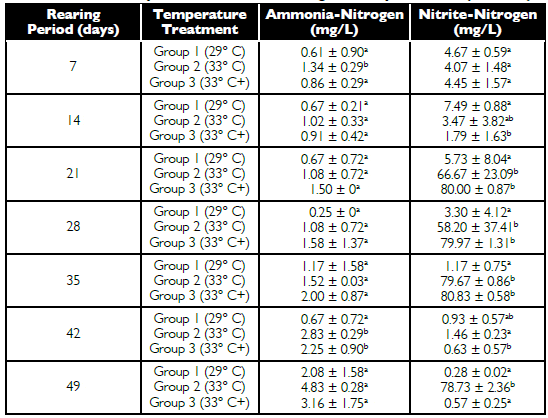
Laboratory Tests
Laboratory trials at Kasetsart University
in Thailand compared how two experimental
temperatures affected Pacific white
shrimp. Animals averaging 12 g each were
stocked into aquariums with a salinity of 25
ppt at 10 animals/aquarium. During the first part of the trial, feed was given at 3%
of shrimp body weight in three doses of
1%/day at 29 C, while at 33 C, feed was
given ad libitum for two hours.
Three replicates were made for each
temperature and feed dose. Then, in the
second part of the lab experiment, feed
consumption was compared for three
experimental groups:
Group 1 Temperature 29 1 C and
feeding at 3% body weight
Group 2 Temperature 33 1 C and
feeding at 3% body weight
Group 3 Temperature 33 1 C and
feeding at 36.5% more than
3% body weight.
Laboratory results indicated that average
feed consumption was 36.5% higher
at 33 than at 29 C (Table 1), although
growth was similar at both temperatures
(Table 2). However, at 33, survival was
lower due to deterioration of the water
quality. Levels of ammonia-nitrogen and
nitrite-nitrogen were higher (Table 3),
thus giving this group the highest FCR
due to low survival. Also, when feed was
restricted to 3% of body weight at 33,
growth was lower, indicating the shrimp
needed more feed to attain normal
growth at this temperature.
Table 1. Feed Consumption of L. Vannamei at Different Temperatures Under Laboratory Conditions.

Field Trials
Field trials took place at an intensive
culture farm in Naozhou dao, Guandong
Province, China. Six ponds with an average
area of 0.25 ha were stocked at an
average of 144 shrimp/m to evaluate
temperature and feed demand during the
July-September cycle.
A commercial feed table was the main
reference for the daily feed doses. Feeding
adjustments were made based on evaluation
of leftover feed in feeding trays and/or
intestine color checks using a technique
described by Dr. Carlos Ching. In Chings
method, overfeeding is identified when
more than 10% of the guts sampled show
the brownish color of artificial feed one
hour before feeding. Underfeeding is suspected
when intestines show more than 40% blackish color from natural food one
hour after feeding.
Table 2. Performance of L. Vannamei at Two Experimental Temperatures Under Laboratory Conditions. Values in the Same Column Followed by Different Letters are Significantly Different (P < 0.05).

Table 3. Concentrations of Ammonia-Nitrogen and Nitrite-Nitrogen During Temperature Trials Under Laboratory Conditions. Values in the Same Column Followed by Different Letters are Significantly Different (P < 0.05).

Temperature and feed consumption
data were taken over 40 days. Days 21 to
40 had higher temperatures, and days 41 to
60 had lower temperatures. Shrimp weights
were sampled every few days to determine
the average daily gains.
At average temperature ranges from
30.5 to 33.2 C during days 21 to 40, feed
consumption was 30% above the amount
suggested by the feed table, while at average
temperatures from 28.6 to 30.4 C
during days 41 to 60, consumption was
similar to the table values (Table 4). On
the other hand, average daily weight
gains were similar during the whole production
cycle (Table 5), but feed-conversion
ratios were higher (1.64) for days 21
to 40 than the 1.26 average value at the
lower temperatures of days 41 to 60.
Water deterioration was observed during
the high-temperature period. Layers of
dead microalgae appeared on the surface
of the pond, and organic matter increased
on the bottom. This is due to higher feed
doses at higher temperatures, where feed
supplied excess nitrogen and phosphorus
to the pond and caused increases in algae.
Later, when temperature decreased
and feed doses were lower, the dead
microalgae disappeared. It was also
observed that at higher temperatures, dissolved-
oxygen concentrations decreased
but were never below 3.0 mg/L.
Table 4. Feed Consumption During Two Periods of the Same Production Cycle in the Intensive Culture of L. Vannamei. Values in the Same Column Followed by Different Letters are Significantly Different (P < 0.05).

Table 5. Growth and FCR at Different Temperature Ranges During Intensive Culture of L. Vannamei.

August 2012



